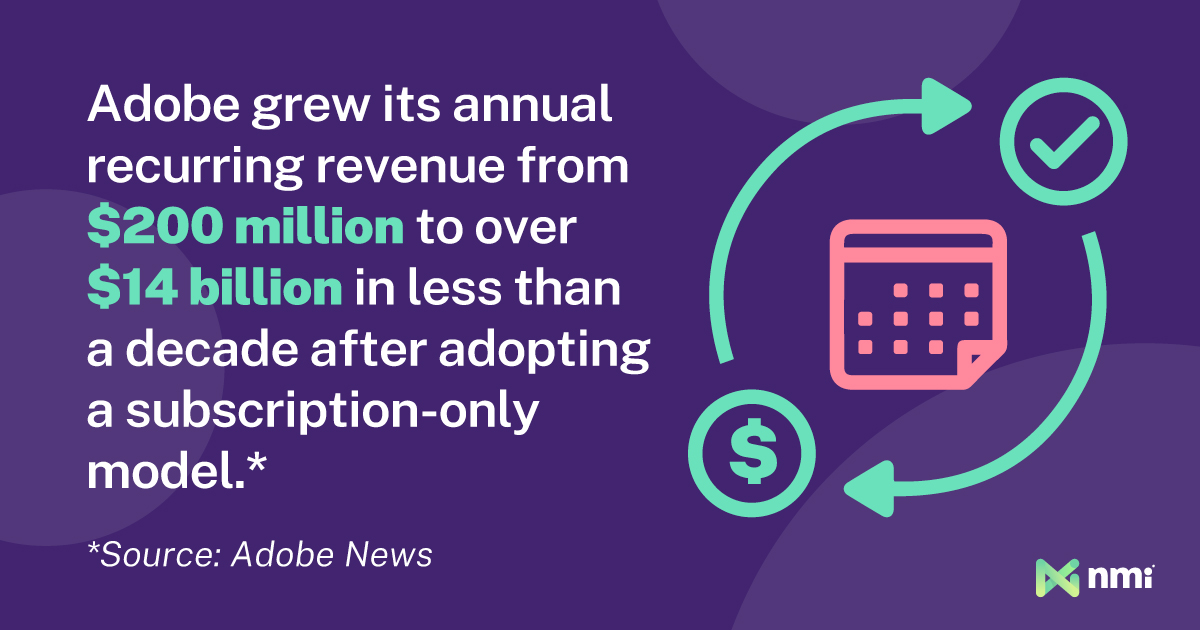Before the widescale digitization of our lives, most things—media rentals, groceries, video games and software—were regular one-time purchases.
However, services like Netflix, Spotify, The New York Times, HelloFresh, Adobe Creative Suite and Amazon Prime have influenced our experiences as consumers. While each serves a distinct market, they all have one thing in common—subscription payments.
In this series of posts, we’ll dive into the world of subscription payments, including:
- Why subscriptions are growing rapidly
- Why subscription payments are valuable for merchants
- Different types of subscription models
- Key components of subscription payments
- Best practices for subscription models
- Common challenges subscription merchants face
By the end, you’ll have a stronger understanding of this part of the payment processing world and its influence on our daily lives. But first, let’s start with the basics.
What Is the Subscription Payment Model?
Subscription payments are recurring payments for products or services billed and delivered periodically—generally weekly, monthly or yearly. In today’s digital world, subscriptions are expanding into areas where they traditionally have not existed. A few examples include:
- Streaming services
- Software as a service (SaaS)
- Gaming services
- Subscription boxes
- Meal kits
Subscription payments can be a lucrative way to generate recurring revenue. They are often more affordable and flexible than conventional purchases, resulting in happier customers and more predictable profits. Because of these benefits, the subscription market has grown substantially over the past decade. This new model has not only changed how businesses position their services but also turned the traditional shopping experience on its head.
The Rise of Subscription Payments
The subscription model has exploded in recent years, offering significant benefits to sellers and customers. Between 2012 and 2020, subscription commerce grew by over 400%, with the subscription economy predicted to be worth $1.5 trillion by 2025.
The digital subscription market (which includes solutions such as Spotify, Netflix and Adobe) is the dominant channel driving growth in the industry. In 2020, this market segment represented $650 billion in value. However, physical product subscriptions (such as Book of the Month or HelloFresh) have also gained traction, with these subscriptions predicted to make up half of the overall subscription economy.
Why have subscriptions become so popular in such a short time? Research from PwC Global suggests that:
- 51% of customers prefer subscription models because they’re more convenient
- 47% prefer subscriptions because they’re more cost-effective
- 42% prefer subscriptions because they help maintain a consistent routine
These numbers indicate how much value subscriptions offer, both to businesses and consumers.
Another benefit is that subscriptions automate processes that consumers once had to perform manually. With a subscription, consumers can effortlessly receive new music, movies and games directly to their homes and devices each month. They can even restock everyday products like toilet paper or razor blades on a subscription basis through companies like Amazon Prime, Dollar Shave Club and others.

The Business Case for Subscription Services
For businesses, subscriptions generate stable recurring revenue without continually reselling to customers. This stability leads to fewer manual workflows and higher lifetime customer value.
For instance, a customer buying razor blades at a big box store chooses from several brands each time they walk through the aisle. Each purchase represents a micro-competition as customers consider whether a new model is out or if a brand is having a great sale.
Subscription providers avoid that competition entirely. When someone subscribes to Dollar Shave Club, the blades are delivered each month, requiring zero thought or action. It’s a true win-win for both parties.
Subscription customers also spend more, sometimes as much as 250% more. That’s especially true for the software market. Customers used to buy software once and use it for several years. Now, most software solutions have moved to a subscription model, where their license never expires —a lucrative shift for many providers.
For example, Adobe grew its annual recurring revenue from $200 million to over $14 billion in less than a decade after adopting a subscription-only model.
Generational preferences are also key to subscription commerce. Nearly 50% of Gen Z and millennial consumers prefer subscriptions—far higher than any other demographic. As the economic power of these two groups grows, with Gen Alpha following suit, the spread of subscriptions will continue.
The subscription model is popular among businesses because it:
- Offers sustainable, recurring revenue streams
- Enhances the customer shopping experience
- Lowers the barrier to entry with flexible, affordable purchasing options
- Makes it easier to update and adjust the product/service as issues arise
- Appeals to younger generations
- Streamlines the sales cycle (with smaller recurring payments vs. large lump sums)
Subscription payments are here to stay, and the market is growing by the day. With more consumers seeking subscription options from merchants, payments providers, developers and software vendors must be aware of this evolving trend.
Stay tuned for part two of our Subscription Payments 101 series to learn about the different types of subscription payment models and the benefits (and downfalls) of each.
To learn more about how NMI can help you provide your merchants with everything they need to thrive in the subscription economy, reach out to a member of our team.




